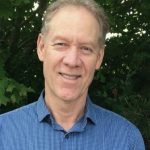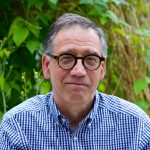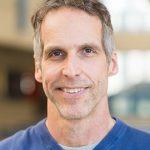
Meet Dr. Michael Blake: Corn-Fueled Curiosity
Of all things to study, Professor Michael Blake’s top pick is corn. He says that’s because big events in human history sometimes hinge on the smallest things. Blake has taught in the Department of Anthropology since 1986. His corn-fueled curiosity has seen him spend a good part of the last 30 years in Latin America and, above all, Mexico, where corn was first domesticated.

Meet Trevor Barnes: Discovering where ideas come from
Discovering where ideas come from.
Ever since he joined the Department of Geography in 1983, Professor Trevor Barnes has tried to do more than expand the minds of his students. He has tried to expand the narrow focus of his own discipline. “I always want to say to my students, ‘Where do ideas come from?’” Barnes explains. “They don’t just come like lightning out of the blue sky, but they come from particular kinds of practices, which are bound up with culture, with politics, with cultural division.”
Origins of Geography
Barnes says we need to look no further than the first geographers for an example of what he means. During the 19th century, when the colonial powers were scrambling to lay claim to vast swaths of Africa, rulers turned to geographers to survey and understand the wealth of the land — and more often than not to fight wars over their respective empires. “That’s where the discipline gets going,” says Barnes, who started out as an economist — a field he says he found too “narrow, purified and abstract” — before going into economic geography.
“Geography is so much about variety, diversity and context that it just doesn’t fit with the notion that there are these essences, that there are these unimpeachable cores,” he says.
Research and Recognition
Beyond the classroom, Barnes has been a leading figure in re-theorizing economic geography through a close analysis of its underlying values. He has shown how dominant social attitudes have influenced the work of geographers just as much as rational scientific practices. The results have earned Barnes many distinctions, including the Presidential Award of the Association of American Geographers in 2006.
These days, his research focus on the topic of creative cities — urban centres such as Vancouver that are moving beyond an industrial economy. He is especially interested in how they vie with each other to lure an educated workforce in the information age. Aside from his interest in modern cities as a subject of research, he says it’s also a subject he likes to teach. “I think that’s the course that students enjoy most, because it’s about them and their lives; they can step out of the classroom and they’re there.”
Challenging Students
But Barnes also likes to leverage the shock value of the dramatic changes he sees unfolding in the world’s economy.To get his students thinking about globalization and consumer culture, for example, he tells them how Wal-Mart imports about 15 per cent of China’s total manufactured output. China, he reminds his students, is the biggest manufacturing country in the world.“You almost hear this collective sucking in of breath, when you say a fact that they didn’t know before.”
Still, facts by themselves don’t make a good course, nor are they going to help students understand a complex, changing world. “They have to be placed within a larger context,” he says, which is where his particular perspective comes into play.
“My stories tend to be critical. I mean, I’m on the left, politically, so I’m suspicious of what goes on in the name of capitalism. And so I try to raise those issues about some theme below the surface.”
Meet Anne Gorsuch: Exploring nuclear missiles & Soviet youth
There aren’t that many cultural historians who can count a nuclear ballistic missile among the reasons for their career choice.
But Professor Anne Gorsuch, who teaches in the Dept. of History, is one of those few.
It was while working as a lobbyist against the American MX missile project during the Reagan years that Gorsuch decided to go back to graduate school to learn more about the Soviet Union. “I didn’t know as much as I had to know about nuclear weapons, or Soviet-American relations in order to do this job well,” Gorsuch explains. “In those days, if you wanted to experience the Soviet Union first hand you had to be either a member of the State Department, or an academic.” Gorsuch, who has been listed as a “popular prof” several times in Maclean’s Magazine, chose the latter route and has not looked back since. She teaches courses about the Soviet Union and the cultural history of the Cold War, and has been chair of the History Honours program.
Not that it has always been an easy path to follow. From setting out to get a doctorate degree at the University of Michigan without ever having taken a Russian language class, to sharing a tiny dormitory room in Moscow with a swarm of cockroaches, there have definitely been some bumps along the way.
Gorsuch’s first book was about Soviet youth in revolutionary Russia. Her current research is on Soviet tourism to foreign countries in the 1950s and 1960s, something permitted only after death of Joseph Stalin. “What did it mean to be ‘Soviet’ after Stalin?” Gorsuch asks outlining questions she hopes to address in the research. “What was the impact of imagining and experiencing the outside world on Soviet identity both individual and national?”
Gorsuch believes that research has an important place in the classroom. “My own research contributes to my excitement and engagement with Soviet history which I try to share with my students,” she says. “It also ensures that what I teach is up to date and informed by recent interests and academic currents in the field.”
She encourages students in her classes to look beyond arms races and summit meetings to focus on the more personal side of Cold War, as related by memoirs and other individual accounts. To students considering history, Gorsuch’s advice is simple — do it! “A history degree provides training in how to think, how to write, how to make an argument, how to understand the world around you, how to empathize with others,” she says, “All skills needed in any work environment.”
By Nick Melling (BA ’06)

Meet Dr. Stephanie Spacciante: Soaking up Culture
Stephanie Spacciante says she launched the Summer Study Abroad program in the Department of French, Hispanic and Italian Studies with one thing in mind: that you can only do so much in the classroom. “You can learn a language,” explains Spacciante, a lecturer in the Department of French, Hispanic, and Italian Studies and founder of of the Summer Study Abroad program, “but you can’t learn the culture unless you’ve lived there.”

Meet Dr. Dietmar Neufeld: Exploring Religion
Professor Dietmar Neufeld believes that an effective teacher is someone who can perform the story. “In the beginning was the word, and the word was performance.” So goes one of Professor Dietmar Neufeld’s mantras, which is also a tool he uses for unearthing the origins of Christianity.

Meet Neil Guppy: Using Sociology to support students
Sociology Department Head and Professor, Neil Guppy, believes in the power of student initiatives, especially Student Directed Seminars.
Guppy has been the Sociology Department Head for 4 years, in which he has worked to ensure the best possible experience for UBC students and faculty.
“My most important duties are hiring new faculty in conjunction with my colleagues, trying to provide a supportive environment for learning and research, and trying to represent the interests of sociology students and faculty, and the university more broadly,” he described. In addition, Guppy teaches several sections of Sociology 100, a popular first-year survey course.
During his UBC career, Guppy has had a hand in some of UBC’s most popular outlets for student engagement; including working with UBC’s unique first-year orientation, Imagine UBC, and helping to create the Student Directed Seminars (SDS) program.
Guppy coordinated the inaugural SDS program with former AMS president, Vivian Hoffmann. Hoffmann was interested in creating opportunities for students to lead learning. She based her proposal upon a program she witnessed while studying at the University of California, Berkley. Hoffmann brought her idea to Guppy, looking for support and guidance.
“She came to see me because I was the Associate Dean, and most responsible for student issues,” Guppy remembered. “She and I constructed and implemented what is now the SDS seminar.”
The SDS program is an extension of UBC’s Directed Studies program, which allows students to work one-on-one with a professor doing research in a narrow field. SDS courses are designed and directed by students with the assistance of a volunteer faculty member. The SDS Advisory Committee reviews and approves final course outlines before they are offered for registration. Guppy has served as chair on the SDS Advisory Committee for the past six years.
Proposed classes must be on a topic that is not offered at UBC, and have a minimum registration requirement of eight. Students in third year and above are encouraged to submit applications by the deadline. Past courses have included: Think Globally, Act Locally: Citizenship in Vancouver; Chick Lit: Making (Over) a Context; Lifting the Veil: Representations of Middle-Eastern Women; and Graphic Novels: Legitimizing the Genre. SDS courses can span across all faculties and departments.
“We did it as an alternative way for students to engage with topics that weren’t in the UBC curriculum.” Guppy said, explaining that students flourish when they are given the chance to pursue topics they are passionate about. “I believe it’s been tremendously successful. Students are very engaged with learning in the program.”
“My favourite example is the concluding workshop that students had in a hotel in the Downtown Eastside, where they had been exploring alternative ways of representing social change. It was just a very moving, very involved, very passionate three hours of presentation and debate and dialogue with 40 or 50 members of the Downtown Eastside community.”
“Like Imagine UBC, which I was also very involved with when it started, it happened because a student at the University had a really good idea and we were able to jointly implement it,” he said.
“Many of our students have had many good ideas and have been able to push and work them in ways that are beneficial to generations after them.”
By Meghan Roberts (BA 2008, English Literature and International Relations).

Meet Todd Handy: Integrating learning outside the classroom
Todd Handy is no stranger to working with students, both in and out of the classroom.
A UBC Psychology Professor, Handy interacts with students on daily basis. Director of the UBC Neuroimaging Lab and formally affiliated with the cognitive neuroscience lab, Handy likes working with undergraduate students in research positions because of the unique perspective they bring. He cites their “creative input” and inquisitive nature as assets to his lab environment. In addition, Handy enjoys seeing students become excited by the research they conduct; he remarks that “It’s reinforcing when you see students […] get charged up by issues and questions we’re pursuing.”
“I’ve really enjoyed being able to meet and understand and get to know students in ways you couldn’t in the classroom,” Handy said. “As a teacher I think it’s invaluable and helps understand the mindset of students and what they like and don’t like in classes.”
Heavily involved with students as a faculty mentor and co-chair of the former Faculty of Arts Academic Commuter Transition program, Handy took his teaching to the next level. FAACT was a UBC Peer Program that catered towards the distinct transition needs of first-year commuter students, and gives them a positive beginning to their UBC experience. He was open to collaborating with students, and when he first started, his hope was to meet with students and find out programs and activities that “might be interesting for them”. Key components of FAACT have now been integrated into ASTU 150.
According to Handy, working with students “helps me understand ways I can improve my teaching.” With a faculty member so involved in student life, it’s no wonder that his department won the 2009/2010 Alfred Scow Student Development Award.
By Meghan Roberts (BA 2008, English Literature and International Relations) and updated by Katie Fedosenko (BA 2011, English Literature)
[Photo Courtesy of CASS]

Meet Dr. Arlene Sindelar: Her Path to History
As an undergraduate at Concordia University Chicago, Dr. Arlene Sindelar studied math. She even taught math as a student teacher before graduating. But it was while student teaching that she made an interesting observation—she enjoyed studying math, she liked teaching math, but she didn’t really think much about math once she left the classroom. Instead, she thought about history. History had always captured her imagination and it was history that drew her back.
UBC film program celebrates its 40th anniversary
Leading international filmmakers will serve as multicultural mentors for UBC film students thanks to a $1-million donation from Canadian communications and media company Rogers Communications. The gift highlights the UBC Film Production Program’s 40th anniversary events held May 5-8. The donation comes as UBC’s Film Production Program and its 350 alumni celebrate the program’s 40th anniversary […]

Capturing student life through UBC Portraits
There is no question that the UBC campus is recognized for its natural aesthetic beauty and appealing locale… but what do we know about the hundreds and thousands of students that walk across campus every day? First year student Rabi Sun has captured the student life in a unique and extraordinary way through his original project called UBC Portraits.
Rabi is a first year Arts student who has taken the art of photography and applied it to his university life in a creative way. For now, he is deciding between a major in Philosophy or International Relations.
Here is Rabi’s take on his life so far as an Arts student at UBC and a bit about his love for photography:
1. It shows that photography is a big passion of yours. What is your main inspiration?
My main inspiration for photography is mainly just the idea of being to capture memories and moments in time with a still image. I am a strong believer of the phrase: “a picture is worth a thousand words”. Maybe not a thousand words, but an image is able to say a lot about something.
2. Pictures do say a lot. So I’ve taken a look at UBC Portraits and found that it is very unique and shows our university in a different light. How did you come up with this particular project?
The way the project works is a very simple idea and has been done many times in various other countries. I came across a Youtube video where two photographers in Britain spent a weekend taking 1000 photos of people of all kind in London in order to show “the true face of Britain.” After my acceptance to UBC, I figured it would be a lot easier to work on the project on campus and a good way to keep my passion for photography going.
3. Interesting, and what sort of things would you like for the visitors of the UBC Portraits blog to take away?
I don’t consider the blog to be “my blog” as it isn’t about me, but about the people who are in the photos. That being said, I would like visitors to the blog to get a sense of the diversity that there is on campus and to hopefully apply that sense of diversity to the city, the country, and even the world.
4. I agree… things happen when you least expect it and a part of life is learning how to adjust to constant changes. Is there any advice you would like to give to other aspiring photographers?
Don’t expect amazing pictures right away. If the photo is not to your standards, you’ll realize that you can take the shot again. It’s best to capture the moment rather than lose it. Photography is 20% luck, 30% vision, and 50% of just keeping an open mind.
Photo courtesy of rabi.sun